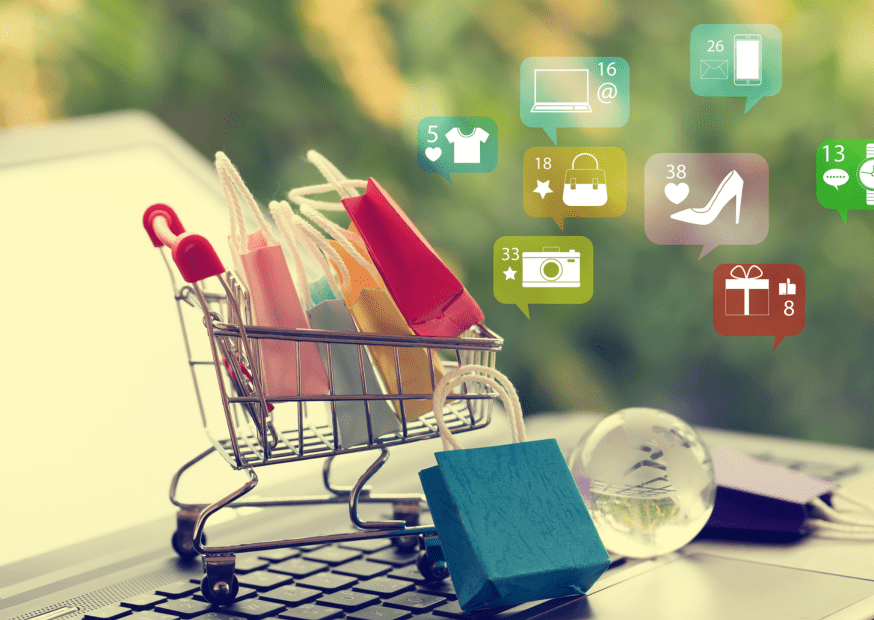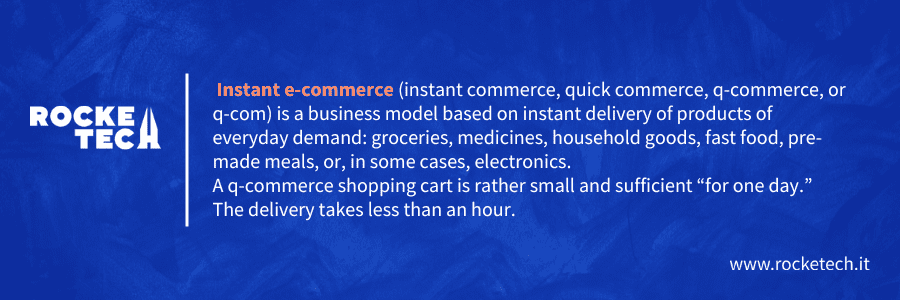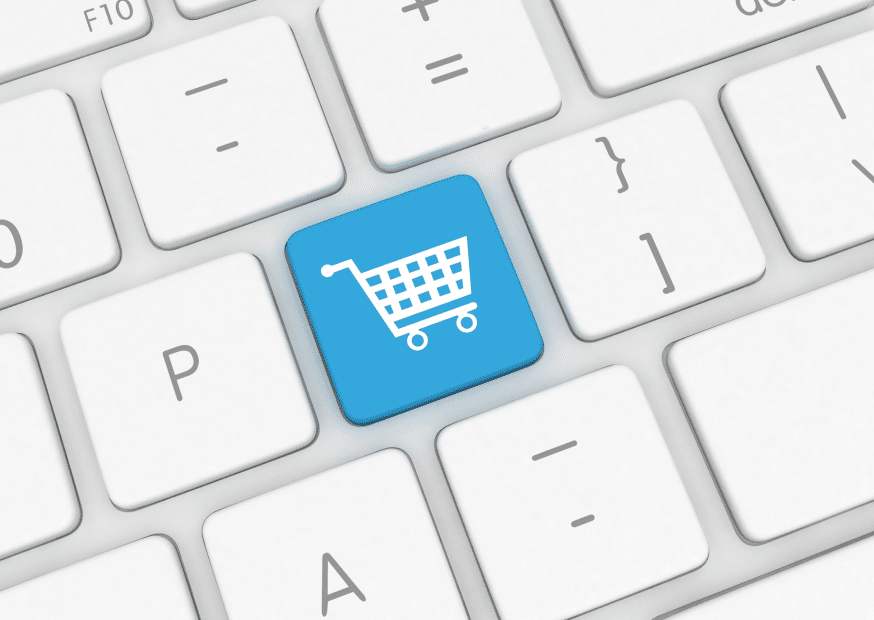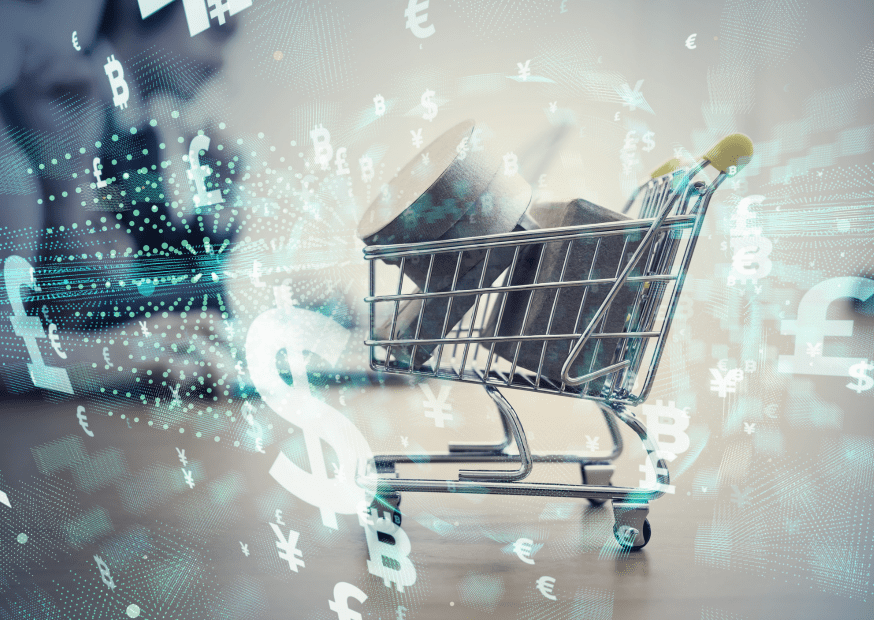Today, nearly everyone is well familiar with e-commerce. This business model redefined the general retail guidelines as online orders have transformed the traditional market. Weekend trips to a supermarket have become a thing of the past as nearly anything is available online. Instant e-commerce has become an inevitable response to the consumers’ growing demand to have what they want ”right here, right now.”
Being one of the latest massive trends, this entrepreneur model is set to reconstruct the global economy soon, creating new business ecosystems around it. This article will help you understand what instant e-commerce is and what it means for big and small companies worldwide.

What Is Instant E-Commerce?
As the name suggests, this concept first focuses on delivery time. It’s also not a new concept as on-demand services have been around for quite a while. Just think of ordering pizza. Only now, businesses take this concept to a whole new level.

The concept has already proved to be successful and has attracted huge investments globally. However, it raises certain challenges — due to its nature, such a model redefines the entire logistic system.
Essentially, q-com is the next step in e-commerce evolution. The global COVID-19 pandemic reshaped how people view online shopping. By January 2021, around 85% of consumers in the US had to change their shopping habits. According to another Statista report, 40% of US respondents said they purchased new brands, and approximately one-third tried new digital shopping methods.
The market and consumer minds were ready for the next generation of e-commerce. Flink, the German grocery delivery company, demonstrated it vividly, raising $240 million half a year after its launch. With rapid technological development, the trend spread globally instantly.
Instant E-Commerce: Features
Despite negative expectations, the global pandemic boosted many online businesses and set up new e-commerce trends. Consumer behavior shows that once people are satisfied with the service and quality, the average bill amount keeps growing. So does the vendor’s revenue. The transformation of the traditional approach has several characteristics.
- It’s decentralized
Mega warehouses are no longer a viable option here. Dark stores become more local as they need to facilitate the promised less-than-an-hour delivery. They mostly look like usual supermarkets but are only accessible to employees.
- It’s available
56% of consumers opt for online shopping because it’s available 24/7. Competition in business is tough. Q-commerce provides the advantage of being competitive if you manage to organize it right.
- It’s local
Instant e-commerce entrepreneurs make connections with local vendors. For example, many grocery q-com businesses also engage local food producers like farmers or butchers.
Using two-wheeled vehicles is another distinctive feature of instant e-commerce. Most delivery people cycle or drive motorbikes, which means fewer chances of getting stuck in traffic and more flexibility. Sustainability and environmental awareness have become a driving force for many fast-growing businesses, funding options, and social support.
Instant E-Commerce: Logistics
Businesses go where consumers go. In reality, it means companies have to adapt to rapidly changing consumer demands. The new approach greatly affects logistics. With huge warehouses and a few days’ deliveries being a matter of the past, here’s how the logistics system differs in the quick commerce model.
- Incredible delivery time
It’s an underlying characteristic of q-comm. Moreover, it may generate extra revenue if implemented correctly, as 65% of consumers will likely pay more for faster deliveries.
- Last-mile problem
The last mile is a logistics term referring to the last stage of product delivery to the end consumer. In e-commerce, it’s the final delivery from a warehouse to the customer’s front door. Delivery delays may negatively impact especially new and small businesses as 58% of US consumers are likely to change the company after a bad customer experience.
- Smaller storage facilities
For example, local grocery delivery services offer a more limited range of products. For logistics, it means less room needed for their storage and fewer employees engaged in maintenance and processing.
- Handling complex products
In contrast to classic online stores selling products of the same type, q-com may need to apply different storage regulations to various types of goods. It can be anything from perishable foods to flammable goods.
- More demanding order preparation model
Each order must be formed within minutes. It may increase the error rate and requires a different level of automatic optimization and accountability. It also involves creating a system to control if the goods are constantly available in the warehouse.
The New Way to Succeed
If your business aims to sell online, it’s worth trying to catch up with the latest mega-trends like q-commerce. It may be an impossible task to compete with industry giants like Gorillas, Delivery Hero, Glovo, Talabat, or Flink.
| A European quick commerce startup Gorillas achieved a “unicorn” status in the venture funding world, having reached an evaluation of $1 billion in less than a year. |
However, small brands and startups can enter the market by partnering with the biggest players. There are some considerations that entrepreneurs should keep in mind.
Marketing and Branding
E-commerce marketplaces and platforms have different partnership agreements. Often, it means less control for businesses using the marketplaces. Creating a website for your business, professionally managing your social media accounts, and investing in targeted advertising are still the main ways to promote a strong brand.
Consumer Behavior Analytics and Customer Care
Large delivery platforms implement advertising tools into their mobile and web applications. However, they mostly restrict access to customer data vital for digital marketing strategies. Establishing your online presence in social media will help you build strong relations with your customers and collect and analyze essential data.
Competitive Offer
Since it’s one of the relatively fresh e-commerce trends, it creates a great chance to distinguish your company from competitors if you offer what they don’t. In this case, instant delivery. It may help attract new customers willing to try new products (or the same products but from other stores) or to get what they want immediately. Besides, your presence in your local community may even work well while competing with e-comm giants like Amazon.

Instant E-Commerce: Technical Side
Small local restaurants traditionally choose marketplaces as they provide already established infrastructure. However, as q-commerce is reshaping the industry, more and more businesses have great opportunities to launch web and mobile apps and partner with logistics companies.
Once your business is ready for its own solution, it’s vital to stay up-to-date with the latest tech trends affecting the industry. For example, artificial intelligence, machine learning, AR and VR technologies, and cloud services are confidently winning in every economic sector.
Having analyzed multiple successful projects, Rocketech’s experts outlined a set of soon-must-have features for an e-commerce tech solution to help the business grow and succeed.
M-Commerce (Mobile Apps)
According to Techjury, 79% of smartphone users have shopped online using their mobile devices in the past six months. Moreover, the mobile share is estimated to make up 72.9% of total e-commerce sales this year.
It makes it essential to provide the user with all the necessary information while they are using a smartphone: a large photo, full description, characteristics, payment and delivery options, reviews, videos, and product ratings.
Often, users choose products on mobile devices and finalize the purchase in a desktop version. Here, a seamless customer experience is key — both versions should be equally convenient, informative, and functional.
Multiple Payment Options
If your business wants the consumer’s money, it has to provide as many ways to get it as possible. 42% of US consumers abandon the shopping cart if the seller doesn’t provide their preferred payment method.
Today, the classic methods like debit or credit card payments and direct bank transfers should be accompanied by fast transfers: PayPal, ApplePay, GooglePay, Samsung Pay, Facebook Pay, Klarna, e-wallets, Payoneer, and others.
Next-Level Personalization
Today’s consumers expect all communication between them and the business to be tailored to their unique needs. This is exactly what 50% of shoppers anticipate when visiting any online store. On top of that, more than 70% of users get disenchanted if the content they see has nothing to do with them.
For example, the baby formula company Enfagrow has mastered timing personalization. While onboarding customers, moms, and moms-to-be, their system collects data about their due dates and sends personalized emails relevant to the baby’s age and development stage.
Well Thought-Through UX
Minimalism is one of the main current trends in e-commerce. The expensive, intrusive design doesn’t solve business problems or generate revenue. The interface should have a pure service function — to connect the user to the app or website and allow them to search, choose, and purchase products.
According to Toptal, 88% of users won’t come back to the web page after a bad user experience. The same reason makes it 62% less likely for them to buy from this brand ever again.
Loading Speed
Loading speed is one of the crucial metrics for your app’s or website’s functionality that greatly affects customer behavior. In fact, 57% of digital consumers will abandon a site, and 80% of them will never come back if the page takes more than three seconds to load. Increasing loading speed is a matter of quality development and the right technologies used for building your end product.
Chatbots
Chatbots are an amazing tool that is becoming more and more popular almost in any customer-related business. They solve several tasks:
- The collect and update client database;
- They open an additional business-customer communication channel;
- They are a perfect and money-effective alternative to call centers — for example, they can check if another size is available, find a similar price model, accept an order, or inform about delivery options and return policy.
Chatbots can greatly save on customer service expenses as they can speed up handling up to 80% of routine questions. Automation of customer communication helps keep customers as they are likely to change the retailer if they don’t get a quick response.
Voice Assistants
Voice commerce is another effective way to save resources while reaching a greater audience and satisfying customer needs. In 2019, Walmart introduced its Walmart Voice Order shopping service integrated with Apple’s Siri and Google Assistant. The service adds the products to the shopping cart in response to the user’s voice command. It also keeps the user’s preferences on brands, packaging, etc.

Our Expertise
Combining advanced business analytics of niche markets and our tech expertise, the Rocketech Team has been engaged in several exciting projects. Together with our clients, we have built functional, in-demand, and cutting-edge e-commerce products.
Chin-Chin
Chin-Chin is a revolutionary local cocktail delivery service in Moscow. Besides cocktails, the service offers a wide range of food, wine, and sets. Main features include item descriptions with photos, delivery functionality with integrated Google Maps API, an order tracking system, and a Telegram chatbot. Having launched the product in the middle of the 2020 pandemic, we helped our Client to save their business and expand their customer reach.
Project Steps
Project Steps is an innovative product combining a fitness tracker, a social network, and a coupon application for dozens of local businesses in Chicago — fitness clubs, restaurants, eco stores, and other businesses supporting and promoting a healthy lifestyle. The app converts users’ steps into discounts and cashback. The main functionality includes personalized statistics, Apple Health Kit synchronization, and two fitness modes: Healthy lifestyle and Weight loss. The product connects people with healthy lifestyles and local merchants and service providers.
Final Thoughts
Being the next evolutionary stage of e-commerce transformation, q-commerce is no longer only food delivery. It also reshaped the entire online shopping industry making a greater impact on the global economy. It provides more opportunities for small and mid-sized enterprises to grow their businesses. For larger companies, it means reaching out to more people.
At Rocketech, we provide thorough business analytics to each of our Partners. Using our experience and expertise in e-commerce, we outline a set of the most useful features for every project and its specific business objectives, whether it’s a small shop for handmade items or a huge marketplace.
The trend creates new job opportunities in local communities and promotes technological thriving. Most experts forecast the quick implementation of drone technologies and robotics. Instant e-commerce may still be a relatively new trend. However, observing how fast the industry pioneers grew into billion-worth industry giants, one can say the trend is set to develop and stay. It’s aimed to make people’s life easier and more convenient. It will likely go way beyond grocery delivery and become an “instant delivery of anything” trend.
Our experts will make a tailored plan for you.